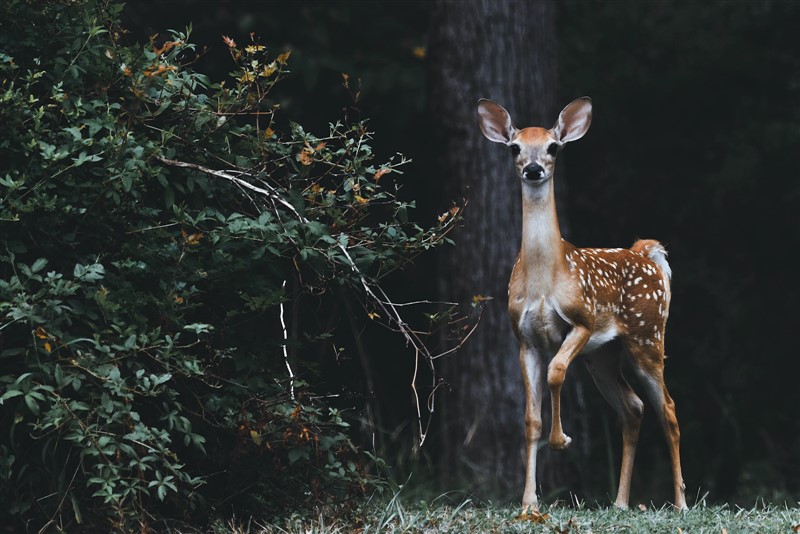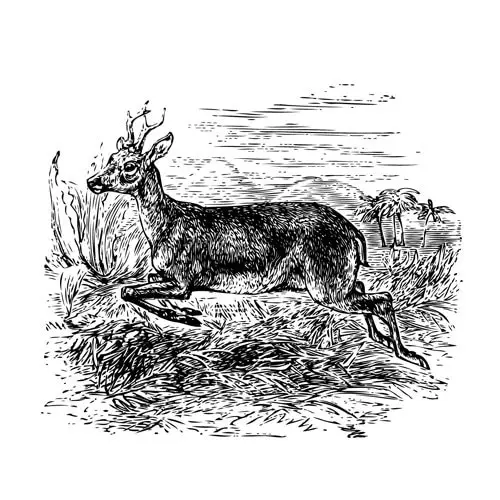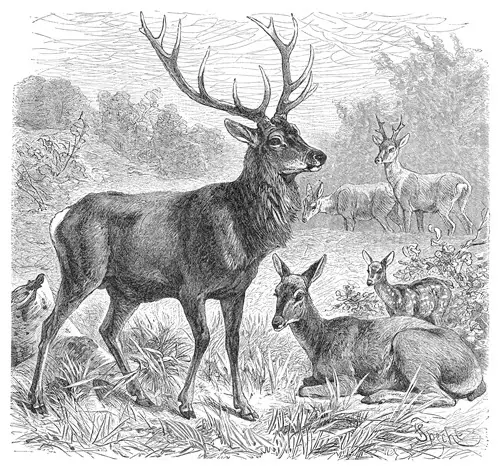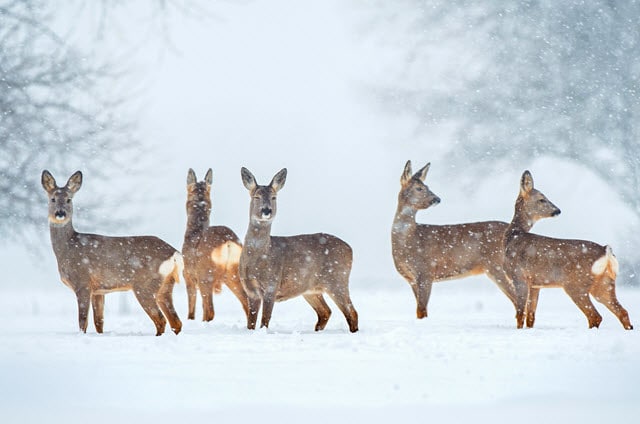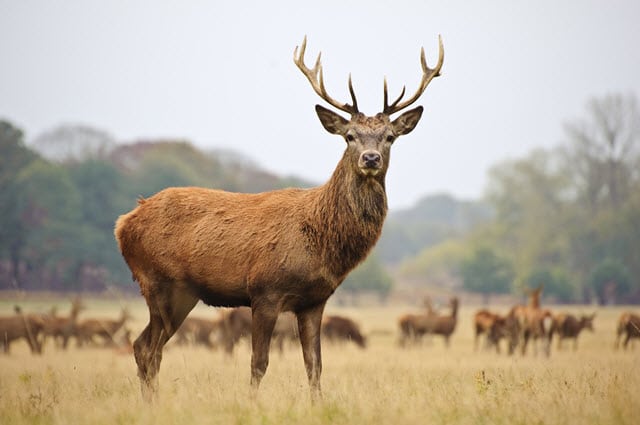If you have ever second-guessed yourself on what the plural form of deer was and also wanted to learn more about the word, it’s grammar, it’s history, and plenty of examples of it used in a sentence, this article is practically made for you!
What Is the Definition of the Word Deer?
According to Merriam-Webster.com, the word deer has these definitions and uses.
- Any of various slender-legged, even-toed, ruminant mammals (family Cervidae, the deer family) having usually brownish fur and deciduous antlers borne by the males of nearly all and by the females only of the caribou.
- Archaic: animal
- Especially a small mammal
Why Is It Deer and Not Deers?
The word deer can be singular and plural in its normal spelling. This word is similar to other animals/types of animals. Look at this in the same context as the irregular plural forms of fish and sheep. You can actually use the word deers, it is not widely used and typically is used when discussing two or more species of deer.
There are many words in the English language that follow this same rule of thumb as collective nouns. You might have been taught in the past that the plural noun deers is always incorrect but in reality, it can be used but perhaps it will not be accepted in class or on academic papers.
The History and Origin of the Word
If we take a look back into history, deer has an interesting path to its current meaning. The old English word for deer was deor. Deor was used to refer to animals both domesticated and also animals in the wild. It didn’t have a specific animal or type of animal but rather was a synonym for animal. Similarly, the Dutch word for animal is dier.
As time progressed it went from being about animals wild and tamed to animals that were hunted. In England, a common animal to hunt was the red deer. At the time red deer were the most common animal to be hunted so it is fitting that it went from being such a generic definition to such a specific. Over the years following the term started to cover other animals that were similar to the red deer. So the definition went from being very general to very specific to sort of general again.
The word deer was used back before the 12th century. The root of the English word deer came from the Old English deor beast. There is some similarity in this root word to the German word tior. The Germanic word tior is defined as a wild animal. There is also some similarity to the Lithuanian word dvasia which means breath and spirt but referred to all animals.
Examples of the Word in Context
- The only strike resulting in significant damage to an aircraft was one of the deer encounters, according to the FAA data. — Rick Steelhammer, chicagotribune.com, “Dog reduces wildlife, aircraft encounters at West Virginia airport,” 25 Aug. 2020
- The timeline for planting food plots for deer and other wildlife falls into two main windows—cool-season and warm-season. — The Editors, Field & Stream, “Three Things to Consider Before Buying Food Plot Seed,” 24 Aug. 2020
- The stiltgrass doesn’t provide meaningful nutrition for deer, rodents or other animals and offers very little habitat for insects or pollinators. — Greg Stanley, Star Tribune, “University of Minnesota botanist discovers feared invasive Japanese stiltgrass in Wisconsin,” 22 Aug. 2020
- According to Gun Digest, Winchester fitted its rifles with a 1:10 twist barrel which would stabilize heavier bullets for deer and antelope hunting. — Alex Robinson, Outdoor Life, “3 Forgotten Cartridges Found on the North Dakota Prairie: .225 Winchester, .307 Winchester, and the .244 Remington,” 21 Aug. 2020
- Another story reported some deer playing in a field. — John Carlisle, Freep.com, “On remote Beaver Island, small-town life is preserved,” 21 Aug. 2020
- The 2020 Wisconsin archery and crossbow seasons begin Sept. 12, with the nine-day gun deer season running Nov. 21-29. — Paul A. Smith, Milwaukee Journal Sentinel, “Bonus antlerless deer permits available beginning Aug. 17,” 8 Aug. 2020
- These have included sightings of deer in London and Japan, moutain goats in Wales and wild boars in Italy. — Fox News, “COVID-19 lockdown reveals human impact on wildlife, researchers say,” 23 June 2020
- His body has been completely airbrushed to resemble that of a deer, every muscle painted in soft browns and beiges. — Seija Rankin, EW.com, “Get a first look at Ryan La Sala’s anticipated sophomore novel, Be Dazzled,” 18 June 2020
Types of Deer
Subfamily Capreolinae
- Brocket (genus Mazama)
- Caribou or reindeer (Rangifer tarandus)
- Moose (Alces alces)
- Mule deer (Odocoileus hemionus)
- black-tailed deer (O. hemionus columbianus)
- Roe deer (Capreolus capreolus and C. pygargus)
- White-tailed deer (Odocoileus virginianus)
- Key deer (O. virginianus clavium)
Subfamily Cervinae
- Barasingha (Rucervus duvaucelii)
- Chital (Axis axis)
- Fallow deer (Dama dama)
- Muntjac (genus Muntiacus)
- Père David’s deer (Elaphurus davidianus)
- Persian deer (Dama mesopotamica)
- Red deer (Cervus elaphus)
- Elk (C. elaphus canadensis)
- Sambar (Rusa unicolor)
- Sika (Cervus nippon)
Subfamily Hydropotinae
- Chinese water deer (Hydropotes inermis)
Extinct Deer
- Irish elk (Megaloceros giganteus)
Ending
Now you are no doubt an expert on using the correct plural form of the word deer and hopefully also took away a lot more about the word. Next time you are writing a paper or doing your homework you can confidently use the correct plural form. I hope that you also took away some interesting knowledge/facts about deer today.
Sources:
- https://www.merriam-webster.com/dictionary/deer
- https://ew.com/books/ryan-la-sala-be-dazzled-first-look/
- https://www.foxnews.com/science/covid-19-lockdown-reveals-human-impact-on-wildlife-researchers-say
- https://www.jsonline.com/story/sports/outdoors/2020/08/08/bonus-antlerless-deer-permits-available-beginning-aug-17/3319583001/
- https://www.freep.com/in-depth/news/columnists/john-carlisle/2020/08/21/beaver-island-joe-moore-news-net/5596483002/
- https://www.outdoorlife.com/story/guns/forgotten-calibers-found-prairie-guns-225-winchester-307-winchester-244-remington/
- https://www.startribune.com/university-of-minnesota-botanist-discovers-feared-invasive-japanese-stiltgrass-in-wisconsin/572194862/
- https://www.fieldandstream.com/story/outdoor-gear/consider-before-buying-food-plot-seed/
- https://www.chicagotribune.com/pets/sns-wva-airport-dog-helps-wildlife-aircraft-encounters-20200825-uugeaxdqvng4fbjfgs3puhyefe-story.html
Kevin Miller is a growth marketer with an extensive background in Search Engine Optimization, paid acquisition and email marketing. He is also an online editor and writer based out of Los Angeles, CA. He studied at Georgetown University, worked at Google and became infatuated with English Grammar and for years has been diving into the language, demystifying the do’s and don’ts for all who share the same passion! He can be found online here.
Whether you’re learning to speak English or are a native speaker, the word “deer” can be confusing. What’s the plural of deer? Well, the answer is really quite simple. The plural of the word deer is “deer”. The same form of the word is used for both singular and plural references to this animal. For example, you can talk about a single deer or several deer.
Is Deers a Word?
While “deers” is considered an accepted plural according to Grammarist and other websites, it is rarely used and may be considered incorrect. “Deer” is the preferred plural form of the word deer.
How Deer is Used in a Sentence
An example of using the singular form of deer would be: “Did you see the deer in the backyard this morning? It was beautiful.”
An example of using the plural of deer would be: “Look at the deer! There must be 20 of them in that field.”
Now let’s take a closer look at the word “deer” and its evolution and uses today.
The Etymology of the Word Deer
Like many other English words, the word deer and its usage depends on its history. Put simply, the singular and plural forms of deer have always been the same.
The history of the word deer stretches back several centuries. We find the beginnings of its usage in Old English. This version of English spanned from around 400 AD to 1066 AD in England.
It was in Old English that it was decided that deer should have the same form in both singular and plural uses.
This is because of the characteristics of Old English, which used a case system. Modern English no longer uses a case system. We are able to achieve the same objectives through word order.
With the structure of Old English, speakers were able to use the same forms for the singular and plural versions of words.
We see remnants of this in how we use the same form of the word deer for both the singular and plural forms.
Why Singular and Plural are the Same
As we talked about earlier, some English words have the same form for both singular and plural uses. The reason for this is simple: it’s a result of the words’ etymologies (history and development).
There are other English words that have the same form for the singular and plural versions. Notably, many of them refer to animals, specifically wild animals that are sometimes hunted or live on farms.
Let’s take a look at some of them below:
- Antelope
- Buffalo
- Moose
- Sheep
- Fish
- Elk
- Moose
There is some variability in usage when it comes to these words, however. For example, you may hear some people refer to plural fish as “fishes.”
However, with some of these animal names, it’s extremely unusual and sounds dramatically incorrect to create a different plural form.
An example would be moose. Wouldn’t it sound strange to hear someone say “mooses”? What about “buffalos”? These are obviously incorrect.
Of course, there are plenty of animals that have names with different singular and plural names. An example is the cow. One cow is a cow, while the plural of cow is cows.
How to Find out if Deer is Singular or Plural
This is one of the trickiest elements of learning English. Sometimes, there isn’t a definite reason for a usage convention.
This certainly applies to somewords that have the same singular and plural forms.
In many cases, we need to get to know and even memorize, through practice, the different words that have the same singular and plural forms.
You can always be sure that deer has the same form when both singular and plural. There is no context where saying “deers” would be correct when referencing a group of deer, though people may understand what you are saying.
But if you’re looking at a sentence and see the word “deer,” how do you know whether the writer was talking about one deer or more than one?
You can tell from the context and other things said in the sentence. For example, if it says “I saw several deer in the field,” it is clearly plural.
What are Collective Nouns?
While deer is a noun and the singular and plural forms are exactly the same, it’s not a collective noun. A collective noun is a noun that refers to a multitude of things.
For example, the collective noun for a group of geese would be a “gaggle.” We talk about “gaggles of geese,” meaning groups of geese.
When it comes to deer, we talk about a “herd” or sometimes a “group” However, these collective nouns are also used for other animals. When it comes to the word “group,” this is also used for humans.
Final Thoughts: Deer or Deers?
As we’ve seen here, the plural of deer is the same as the singular form, which is “deer.” The word “deers” is an accepted plural form of the word, but it is almost never used and is considered less correct.
While many other animal names have different singular and plural forms, deer does not.
English is quite an idiosyncratic language, and there aren’t uniform rules that apply to every word.
You will learn which words have different plural forms and which don’t through practice and getting better acquainted with the language.
You May Also Enjoy:
How do you describe more than one deer, from a perspective of spelling and grammar? It can be a common question among our dear readers, so we’ll address it in today’s discussion.
Let’s arrive at the proper plural of deer, as well as how to make sense of similar questions.
What Is the Word for the Plural of Deer?
Simply put, the plural of deer is deer. So, any of the following sentences would be correct:
I saw a single deer peering out at me from the forest.
While biking across a mountain trail, I came upon a group of deer drinking from a stream.
Several deer were sprinting gracefully through the clearing in the distance.
Why Is the Plural of Deer and Not Deers?
If you came to this article because you were wondering about the plural of deer, the answer might seem confusing at first. After all, similar words are made plural by adding an “-s” to the end. For instance, the plural of beer is beers. So why does the singular deer not become the plural deers?
There are a few reasons for occasionally inconsistent pluralization in English. Our language has drawn many of its words from other languages such as Greek, Latin, and Arabic and inherited nonstandard pluralization as a result. In those cases where we have borrowed and adapted foreign words, the correct plural versions might seem unusual because of their origin with another system of spelling and grammar.
Such words can often be pluralized differently because adding an “-s” would make them difficult to spell or say out loud. For example, the singular knife becomes the plural knives because the incorrect knifes could be more difficult for people to say and hear. This explains why we have plural words such as geese instead of gooses as well.
Some words also are changed by simple convention. American English is a living language that has continued evolving from its British roots during the last several centuries. Words that may have once been spelled or spoken one way have become something different in our modern American society.
The best way to master nonstandard pluralization is to simply become familiar with the variations by reading and writing them with a focus on their correct usage. You can also continue your study of irregular plurals with posts such as Irregular Plurals and Irregular Plural Nouns.
Want More Help With Your Grammar?
Learning grammar can be fun and interesting if you have a desire to develop your precision and eloquence in communicating with others. If you want to enhance your abilities as a communicator, review some of our recent posts with insight and guidelines for other common items of grammar and spelling. You can also ask a question about this post or suggest a future topic in the comments below!
Advertisement
If the article or the existing discussions do not address a thought or question you have on the subject, please use the «Comment» box at the bottom of this page.
Deer is the preferred plural form of deer, a hoofed mammal. Deer are ruminants. In most types of deer, only the males produce antlers. Deer antlers are shed annually. Some species of deer are white-tailed deer, red deer, caribou, moose, fallow deer, mule deer, roe deer and elk.
Deers is an accepted plural, but it is rarely used.
The word deer comes from the Old English word, deor, which means four-legged animal, beast. Also the Dutch word, dier and the German word, tier.
Deer is one of a set of words with irregular plural forms, such as sheep and fish.
Examples
Officials recently said Michigan’s 2014 deer hunting harvest was down about 15 percent from 2013, due in part to severe winter weather in recent years. (The Detroit News)
The company sells breeding stock, while trying to improve offspring to produce male deer, known as bucks, with the big antlers and other characteristics often favored by hunters and game farms. (The Journal Times)
“The number of deer harvested hit a low in the early 1970s at below 100,000 statewide,” Creagh said. (The Daily Journal)
“People assume deer will learn to look both ways, and the dumb ones will be selected out of the population,” said Sandra Jacobson, a wildlife biologist with the U.S. Forest Service’s Pacific Southwest Research Station in Davis, California. (Helena Independent Record)
According to the details submitted to the Ministry of Environment, Forest and Climate Change by Gujarat forest department, the floods claimed lives a whopping 1,670 blue bulls (nilgai), 80 spotted deers, around 10 black bucks and even wild boars that all form the prey base of Asiatic lions. (Daily News and Analysis India)
As a result, unexploded ordnance litters the 18sq km area, posing a threat to the deers, boar and foxes that roam its lands – as well as humans. (The Guardian)
Last Update: Jan 03, 2023
This is a question our experts keep getting from time to time. Now, we have got the complete detailed explanation and answer for everyone, who is interested!
Asked by: Prof. Jovani Larson PhD
Score: 4.9/5
(60 votes)
It is often remarked that all these nouns with invariant plurals denote animals, deer, sheep, fish, swine, which are either herded or hunted; and it has been suggested that both the ‘mass noun’ sense with herd animals and the custom of referring to all hunted animals in the singular (we hunt bear, lion, and elephant as …
Is the plural of deer deer?
noun, plural deer, (occasionally) deers. any of several ruminants of the family Cervidae, most of the males of which have solid, deciduous antlers.
Why is there no s after deer?
If you look in a dictionary you will see that «deer» comes to us from the German «tier», a beast. German does not form the plural by adding an «s» as English does, so one deer, two deer, etc. … So when you get interesting questions like this, look in a dictionary and see where the word came from.
Why is the plural of sheep not sheeps?
The reason «sheep» doesn’t have a separate plural form is by chance. … In Middle English, the suffix -s was appended to nearly all nouns to form plurals. This phenomenon replaced the plural forms of Old English—e.g., Old English handa became hands in Middle English.
Why fish plural is fish?
For some nouns, like fish, there is no difference between the singular form and the plural form. Sometimes, however, people do use regular plural endings for irregular nouns, so in casual conversation you may hear fishes or elks. Some English words come from Latin, and take a Latinate plural ending.
24 related questions found
What is Moose plural?
See the full definition for moose in the English Language Learners Dictionary. moose. noun. ˈmüs plural moose.
What is plural of ox?
plural oxen ˈäk-sən also ox.
Why do we say pair of scissors?
In Vulgar Latin, caesorium referred to a cutting instrument, and this Latin word was singular—even though the cutting instrument it named had two blades that slid past each other. … We began calling an individual scissors a pair to emphasize the matched cutting blades. There’s precedent for it.
What’s the plural of salmon?
noun. salm·on | ˈsa-mən plural salmon also salmons.
What is the plural of a fox?
fox. / (fɒks) / noun plural foxes or fox.
What is plural zero?
noun. ze·ro | ˈzē-rō , ˈzir-ō plural zeros or zeroes.
Is herd of deer correct?
A group of deer is often called a herd.
What do you call multiple deer?
Most people, upon seeing a bunch of deer together, would call it a herd; however, you also could call the group a bunch, a mob, a parcel or a rangale.
What is the plural sentence of deer?
The plural form of deer is also deer. Here are two examples to help you understand the way it’s used: »A deer is an animal that lives in the wild. » »Deer live in the wild.
Does dear have a plural?
The plural form of dear; more than one (kind of) dear.
What is the plural form of elk?
noun, plural elks, (especially collectively) elk for 1, 2. Also called European elk. the moose, Alces alces. Also called American elk, wapiti.
What is the plural form of shrimp?
noun. ˈshrimp , especially Southern ˈsrimp plural shrimp or shrimps.
What is the plural noun for tomato?
tomato. noun. to·ma·to | tə-ˈmā-tō , -ˈmä- plural tomatoes.
Why do we say pair of pants?
“Pair,” from the Latin, means two like things. And pants (pantaloons) were originally two like things. You put them on one leg at a time because they actually came in two pieces. … From the beginning, about the 16th Century, pants have been referred to as a pair.
Is it correct to say a pair of jeans?
To talk about one piece of clothing we say «a pair of jeans«. For more than one we say «pairs of jeans». You can also just say «jeans» for one pair. To call it «a jean» is incorrect.
What is the plural of fish?
The plural of fish is usually fish. When referring to more than one species of fish, especially in a scientific context, you can use fishes as the plural. The zodiac sign Pisces is also often referred to as fishes.
What is plural child?
Children is the plural form of the word child and is used to refer to a group of or many youngsters who are below the age of puberty.
Why is the plural of moose not Meese?
Inevitably, people want to know why, then, the plural of «moose» is not «meese». … This is because, unlike «goose», the word «moose» did not exist in early Anglo-Saxon times, so it couldn’t undergo i-mutation. «Moose» was borrowed from Eastern Abenaki in the 1600s.

